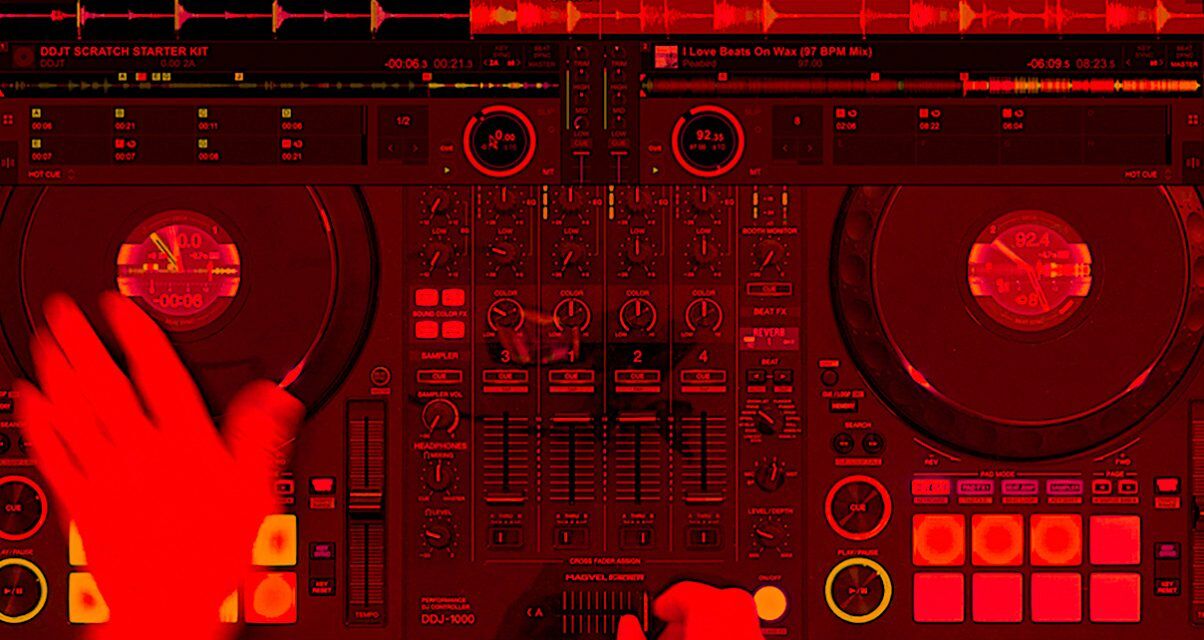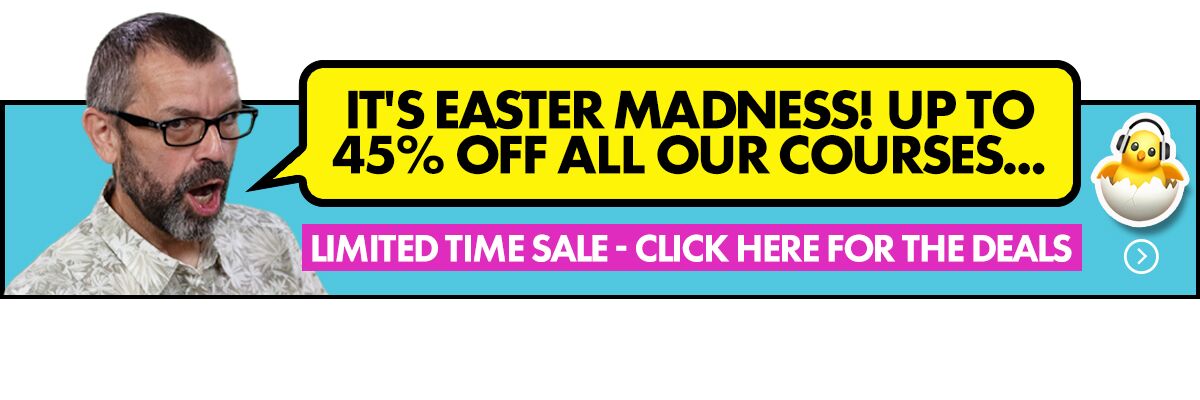Watch the workshop
We’ve taught hundreds of beginner DJs to scratch over the years, and we’ve identified the big mistakes beginner scratch DJs make over and over again. In this article, based on the 45-minute live online workshop embedded above, I talk you through five of them… and give you pointers to help you avoid them.
It’s important you identify and fix these: If you continue to make these mistakes, you simply won’t improve (or at least, nowhere near as fast as you could) – and you’ll more than likely end up abandoning your dreams to learn to scratch.
5 Biggest Scratch Mistakes
1. Mimicking without understanding
It can’t be that hard, right? You watch videos of your heroes scratching, and have a go, you work out where to put your hand on the platter or jogwheel, and study how scratch DJs move their crossfaders.
And then you try it… Ouch!
The problem is, when you’re a beginner, you literally simply don’t know what you don’t know. Just because your hands are making the same movements, it doesn’t sound the same – and worse, you don’t understand enough about scratching to be able to hear the difference yet in your own attempts.
Here is an anonymous, classic example of a DJ who has clearly seen scratching, worked hard to understand exactly what’s going on – but who is mimicking without any understanding whatsoever about what it’s really about, and therefore whose results are poor:
The worst bit is, the DJ who did this probably doesn’t even realise how off the mark it is.
The truth is that without knowing the foundation scratches and fader movements, you’ll never be able to just watch and copy. It’s just how watching somebody playing the piano and then trying it for yourself would be a challenging way to learn, or just how listening to someone speak another language then “having a go” would be likely to lead nowhere!
Get the course: Scratching For Controller DJs
You simply have to get an understanding of the basics before you can “have a go”. (At the end of Mistake 3 I have something for you that’ll help with this.)
2. Blaming your gear
It’s so easy to do this one. After all, you’ve been practising for a long time – it can’t be you, right? But here’s the truth: Whatever gear you have (old turntables, new turntables, CDJs, any type of controller from $50 to $1500…), you are going to have to get very good indeed at scratching before the limitations of that technology become the thing that’s holding you back.
A competent scratch DJ can scratch on anything – take a look at this video of our collaborator Pri Yon Joni scratching on a “lowly” Pioneer DJ DDJ-200 as proof of that:
In the old days of course, everyone had the same gear – so this didn’t arise. But in this day and age, when the chances are that you don’t know anyone else trying to learn to scratch on the same gear that you have, it’s easy to fall into the trap of thinking “if only I had the gear I saw in that YouTube video, I’d be able to do it!”.
Trust us – fixed platter or motorised, big or small, old or now, expensive or cheap – if it’s got spinny things, you can scratch on it. It’s not your gear holding you back.
Read this next: Platters vs Jogwheels – Which Is Best For DJing?
3. Using crap sounds
In a way, the scratch scene is quite conservative, in that there are a collection of instantly recognisable “scratch sounds” that you hear everyone using and that haven’t really changed for decades. But they’re instantly recognisable for a reason: They sound bloody brilliant!
The truth here is that unless you understand what makes a good piece of audio for scratching and what doesn’t, if you’re choosing your own sounds, then the sounds you’re using to try and scratch with right now will likely be below standard. You could scratch like a DMC champ and still sound bad if this is the case.
The solution is to get the classic sounds and practise with those.
That way not only can you rule out the sounds as part of any reason you’re not sounding as good as you’d like to, but as well, you can directly compare your results with those of the pros and of other DJs learning to scratch.
Want the sounds?
Want the sounds? Grab our Scratch Pack here. We’ll send you the audio to load into your software, and also give you a useful PDF that will help you get at least a basic understanding of how this all works, helping you with mistake number one above, too.
4. Using both hands together at the start
Think about changing gear in a manual transmission car. To the uninitiated, it’d look like you sort of push your foot down on the clutch pedal while moving the gear stick a bit, right?
Good luck with that! Of course, those of us who drive know that you remove your foot from the accelerator, push and hold the clutch pedal down, move from the gear you’re in to the one you want to be in, and then slowly release the clutch pedal while resuming the accelerator pedal.
Phew! Not as easy as it looks, right?
It’s exactly the same with scratching.
There are too many moving parts to learn all at once, and so it’s better to split them up. The platter hand and the crossfader hand do different things, and at slightly different times, and this is a crucial thing to work out if you want your scratching to sound good.
Learn to scratch with Digital DJ Tips: Scratching For Controller DJs
The way we drill scratching here at Digital DJ Tips is to coach each hand separately. Then at a slow speed (think clutch control in a car again), we get you to perform it correctly technique-wise, and only do you speed up and combine to get it all working at once.
If you learn this way, it becomes instinctive – but if you don’t, you may NEVER get it. So remember: practise each bit separately.
5. Setting unrealistic goals
Scratching is – to some – a culture, a career, a discipline, an art. It’s serious stuff! Think of somebody at the top of their game in your favourite sport. How long did it take them to get there? Could they have performed at that level from the off? Of course not – and it’s the same level of seriousness with scratching.
If you want to run a marathon (fun fact: three of the team here at Digital DJ Tips are marathon runners….), you need to train for many months, and follow a structured programme. “Just going out running” isn’t enough, and trying to run a marathon in your first week of training is just impossible.
Instead you need to run short, fast runs. You need to follow drills. You need slow, paced runs to build up stamina. You need experience of different weather conditions. You need to get injured and recover to work out how to handle that inevitability. You need to do everything in the right order and react to what happens as you’re training.
And it’s exactly the same when learning to scratch.
So deciding you want to replicate something that you see someone at the top of their scratch game do, and deciding you want to do so THIS WEEK, is unrealistic – you are simply going to fail.
The good news, though, is that you can master 80% of what most people think good scratching is with 20% of the effort!
The easy, early scratches actually sound awesome – and once you combine them, you’ll sound like you can actually do this to nearly everyone who listens to you! That’s why in our Scratching For Controller DJs course, you get early wins on the board, and build on those – in a structured, proven way.
Here’s a 15-second clip of our scratch tutor Steve performing a routine using just the very basic scratches – baby, cut, chirp, tear, and drop. These are the “20% scratches” that you CAN realistically learn pretty quickly:
THIS is where you should be aiming – and it’s perfectly possible. Of course, the work from there on in is to master the rest – but early, easy wins ARE possible if you are structured, and if you’re realistic.
It’s important to realise this so you “pace yourself” properly, and don’t get disillusioned just before it all starts to come together for you.
Read this next: How To Find Time To Learn DJing (Proven Method For Busy People)
Finally…
Scratching is one of the few things in DJing that “can’t be faked”. It is one of the things that everyone from toddlers to great grandparents seem to instinctively understand and enjoy (ask your gran to do her best DJ impression – I’ll bet she cups one hand to her ear like she was holding headphones, and scratches with the other!).
In short, it’s not surprising you want to add it to your skills – it’s an awesome thing to do. Just be aware of the mistakes above, and do your best to work past them, especially at the start – it’ll help you make progress and stop you getting disillusioned.
• Interested in having us help you to learn? Find out more about our Scratching For Controller DJs course here.
So what have you struggled with in learning to scratch? What errors do you see people making the most? Have you committed one of the above, but realised the error of your ways? Let us know below!


